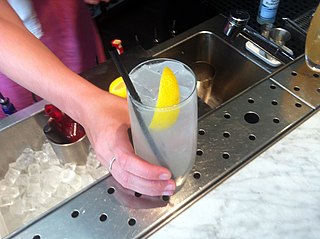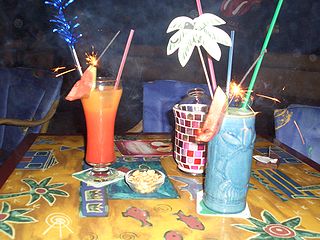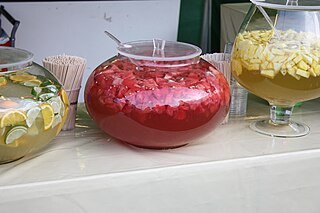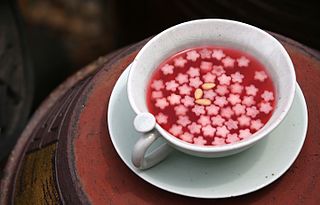
A gin and tonic or, less frequently, gin tonic, is a highball cocktail made with gin and tonic water poured over a large amount of ice. The ratio of gin to tonic varies according to taste, strength of the gin, other drink mixers being added, etc., with most recipes calling for a ratio between 1:1 and 1:3. It is usually garnished with a slice or wedge of lime. To preserve effervescence, the tonic can be poured down a bar spoon. The ice cools the gin, dulling the effect of the alcohol in the mouth and making the drink more pleasant and refreshing to taste.

The piña colada is a cocktail made with rum, cream of coconut or coconut milk, and pineapple juice, usually served either blended or shaken with ice. It may be garnished with either a pineapple wedge, maraschino cherry, or both. There are two versions of the drink, both originating in Puerto Rico.

The Tom Collins is a Collins cocktail made from gin, lemon juice, sugar, and carbonated water. First memorialized in writing in 1876 by Jerry Thomas, "the father of American mixology", this "gin and sparkling lemonade" drink is typically served in a Collins glass over ice. A "Collins mix" can be bought premixed at stores and enjoyed alone or with gin.

A mixed drink is a beverage in which two or more ingredients are mixed. Some contain liquor, others are non-alcoholic. A "spirit and mixer" is any combination of one spirit with one non-alcoholic component, such as gin and tonic, whereas a "cocktail" generally comprises three or more ingredients.

The term punch refers to a wide assortment of drinks, both non-alcoholic and alcoholic, generally containing fruits or fruit juice. The drink was introduced from India to England by employees of the English East India Company. Punch is usually served at parties in large, wide bowls, known as punch bowls.

A sour is a traditional family of mixed drinks. Sours belong to one of the old families of original cocktails and are described by Jerry Thomas in his 1862 book How to Mix Drinks.

Arizona Beverages USA is an American producer of many flavors of iced tea, juice cocktails, and energy drinks based in Woodbury, New York. Arizona's first product was made available in 1992.

The gimlet is a cocktail made of gin and lime juice. A 1928 description of the drink was: gin, and a spot of lime. The description in the 1953 Raymond Chandler novel The Long Goodbye stated that "a real gimlet is half gin and half Rose's lime juice cordial and nothing else." This is in line with the proportions suggested by The Savoy Cocktail Book (1930), which specifies one half Plymouth Gin and one half Rose's Lime Juice Cordial. However, modern tastes are less sweet, and generally provide for at least two parts gin to one part of the lime and other non-alcoholic elements.
A Scorpion Bowl is a communally shared alcoholic tiki drink served in a large ceramic bowl traditionally decorated with wahine or hula-girl island scenes and meant to be drunk through long straws. Bowl shapes and decorations can vary considerably. Starting off as a single-serve drink known as the Scorpion cocktail, its immense popularity as a bowl drink in tiki culture is attributed to Trader Vic.

The Fine Art of Mixing Drinks is a book about cocktails by David A. Embury, first published in 1948. The book is noteworthy for its witty, highly opinionated and conversational tone, as well as its categorization of cocktails into two main types: aromatic and sour; its categorization of ingredients into three categories: the base, modifying agents, and special flavorings and coloring agents; and its 1:2:8 ratio for sour type cocktails.
The brandy daisy is a cocktail which first gained popularity in the late 19th century. One of the earliest known recipes was published in 1876 in the second edition of Jerry Thomas's The Bartenders Guide or How To Mix Drinks: The Bon-Vivants Companion:
Fill glass one-third full of shaved ice. Shake well, strain into a large cocktail glass, and fill up with Seltzer water from a syphon.

Hwachae is a general term for traditional Korean punches, made with various fruits or edible flower petals. The fruits and flowers are soaked in honied water or honied magnolia berry juice. In modern South Korea, carbonated drinks and/or fruit juices are also commonly added to hwachae. Hwachae is often garnished with pine nuts before it is served.

A Polar Bear, After Eight or Peppermint Paddy is a mint chocolate cocktail that tastes like a York Peppermint Pattie or an After Eight wafer. It is usually made from crème de cacao and peppermint schnapps, although crème de menthe is a popular substitute.
Curacao Punch is a cocktail that comes from Harry Johnson's New and Improved Bartender's Manual (1882). Dale DeGroff, a notable bartender and author of The Craft of the Cocktail, holds this to be his favorite forgotten potation.
A Rum Collins is a cocktail based on the Tom Collins substituting a light rum for the gin.
Blow My Skull is an alcoholic punch drink that originated in mid-19th century Australia. As listed in The English and Australian Cookery Book by Edward Abbott, it calls for two pints of boiling water, sugar loaf, lime or lemon juice, one pint of ale or porter, one pint rum, and a half a pint of brandy. It has been described as a "notoriously potent alcoholic concoction".

Chatham Artillery Punch is a potent punch containing rum, whisky, brandy, and Champagne. It also contains lemons and sugar. Named after the Savannah regiment, it is well-known in its the city of Savannah, Georgia.












